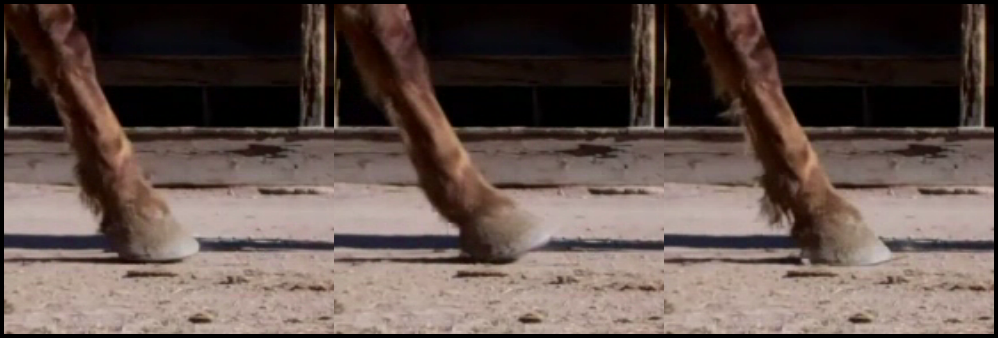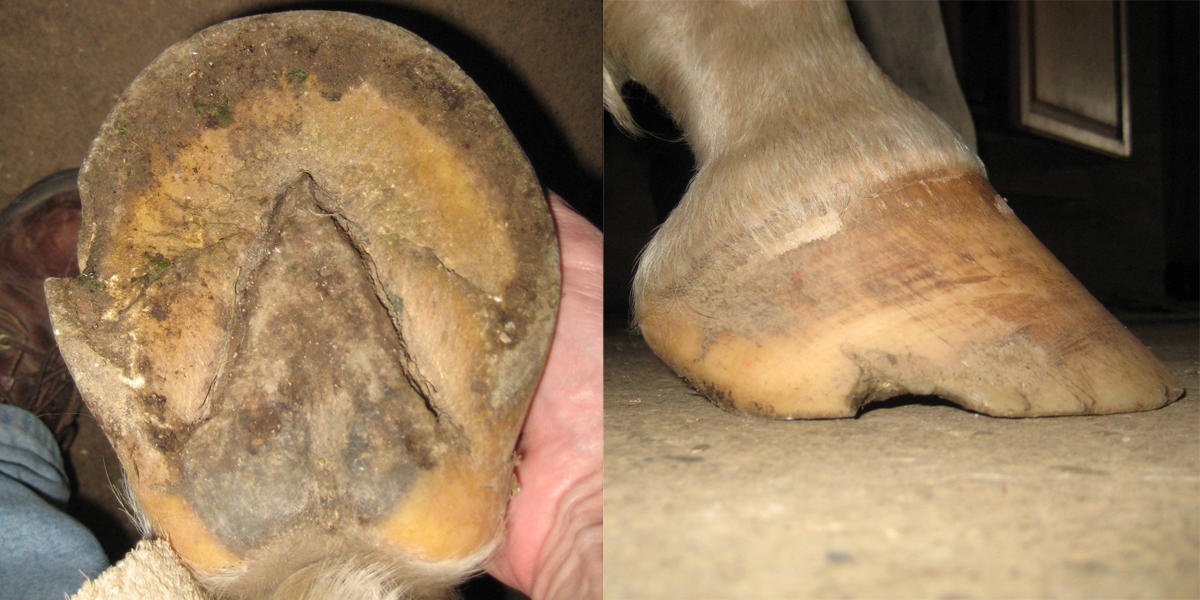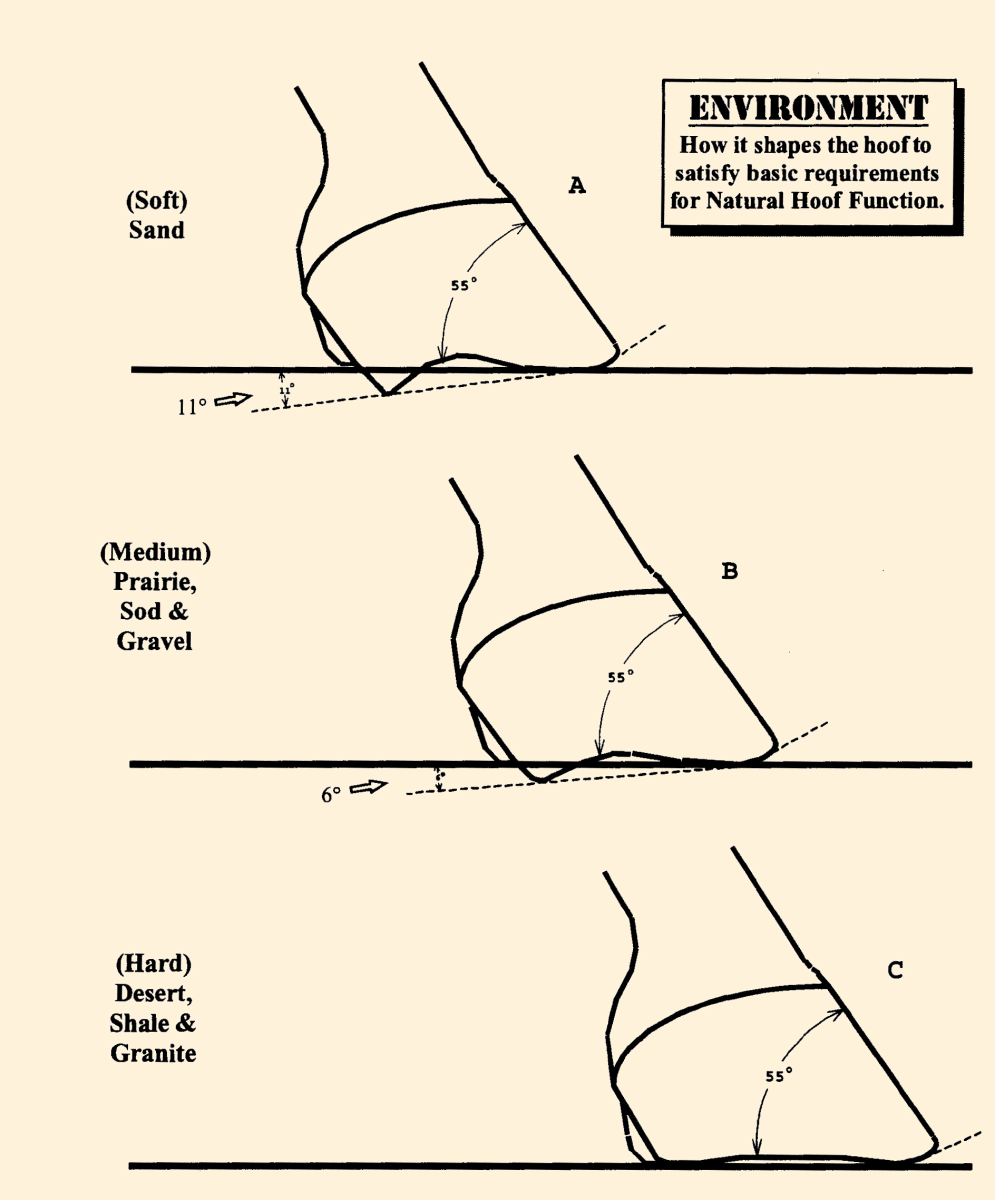Hopefully, Part 1 and Part 2 of this series have laid sufficient groundwork (no pun intended!) for you to now be ready to hear why the feral horse lands flat-footed at the walk. Let’s briefly summarize what we’ve covered so far:
- As a quadruped, the horse’s anatomy and way of going differs from the bipedal human, and therefore his movement cannot be compared to the movement of the human
- The human is incapable of seeing small but significant differences in how a horse lands without the aid of slow-motion video
- Barring injury or other mitigating circumstances, the horse does not actively position his foot for landing
- The mass of the healthy, properly-trimmed equine foot is fairly evenly distributed front-to-back about the center of coffin joint rotation
- Any longer part of the hoof wall relative to the rest of the hoof wall will strike the ground first
- The addition of length or mass can significantly affect the flight arc of the hoof, and, therefore, the way the hoof impacts the ground
And now we need to talk about the effects of movement and terrain on the hoof.
One of the things you may have noticed about your horse, whether he’s shod or barefoot, is that the harder and rougher the terrain he’s used on, the more rapidly his shoes or hooves wear. That’s only logical, since even the steel of a horseshoe is not as hard as many of the minerals present in soil. And given that the typical feral horse travels an average of just under 12 miles per day, it’s no wonder that the constant abrasion results in obvious signs of wear. So if we look at the foot of a feral mustang from a very arid and abrasive environment like the U.S. Great Basin, we see evidence of considerable wear –
Note the pronounced rounding of the wall (“mustang roll”) where it contacts the ground, the arch of the foot in the quarters, the blending of the bars and sole into a smooth, polished-looking surface, and the leather-like appearance of the frog. The entire hoof is very short, with the heels worn back to the widest part of the frog.
In contrast, look at the same features on this domestic Ohio horse, whose typical day consists of about half his time in a fairly wet, grass-filled pasture and the other half in a stall, about 6 weeks after his last trim –
As you’ll note, the wall shows little evidence of wear, with a fairly sharp edge. The arch in the quarters is only evident to the extent that the horse has started to break off excess length in that area in the form of a large chip. The bars are quite a bit higher than the contour of the sole, and the presence of tiny cracks along with the lack of a smooth, shiny appearance suggest that old sole growth has not yet been worn away. The frog has a somewhat “swollen” appearance, and the heels are disproportionately long and therefore well forward of the back of the foot.
These two hooves are rather typical examples at the near-extremes of a continuum of wear, with the consequences of lots of movement over arid, abrasive terrain at one end, and relatively little movement over soft, wet terrain at the other. Keep in mind that the difference in movement between typical feral and domestic horses is tremendous; the domestic horse would have to do 24 laps per day around the perimeter of a 10-acre pasture to equal the distance traveled by a feral horse in the same amount of time!
The relationship between types of terrain and degree of wear was documented by farrier and horseshoe designer Gene Ovnicek. Take a look at this illustration from his book New Hope for Soundness, Second Edition –
As you can see, as the terrain becomes softer, the heels experience less wear. But because the heels actually penetrate the softer terrain, the effective toe angle remains essentially constant. Obviously, if you were to stand these three horses on a flat, unyielding surface such as concrete, or move Horses A and B into Horse C’s environment, only Horse C would measure with the same toe angle as he did in his “natural” environment; Horses A and B would have more upright toe angles because of their longer heels. From what we learned in Part 2, therefore, we know that on a flat, unyielding surface, Horse A is unquestionably going to have a more pronounced heel-first landing than Horse B, who will have a more pronounced heel-first landing than Horse C.
This is why so many people erroneously conclude that horses must be designed to land heel-first; very few of our domestic horses both live in desert environments and move as much as feral horses, which makes them much more like Horse A than Horse C. So it’s logical to assume that every horse we’re likely to observe moving over a flat, unyielding surface, including all feral horses except those from environments like Horse C, will land heel-first to one degree or another. But just because that’s what we happen to observe on flat, unyielding surfaces doesn’t mean they’re supposed to land that way on every surface!
The very important point to be made in this discussion lies in the realization that all three horses in the above illustration share a critically-common albeit not obvious characteristic, in spite of the differences in their environment: at the instant of impact, the coffin joint (the joint between the short pastern and the coffin bone) is undergoing no 3rd-order acceleration. Although the foot as a whole is decelerating as it makes contact, the coffin joint is not also rotating at the moment of impact. Any rotation (3rd-order acceleration) of the joint, as we’ll examine in the next installment of this series to be entitled “Navicular Disease – Part 1: Background,” turns out to be an absolutely crucial factor affecting the long-term comfort and soundness of the horse.
Meanwhile, when we consider all this wear happening to the bottom of Horse C’s hoof from miles and miles of travel over highly abrasive ground, isn’t it a logical conclusion that any part of the hoof that was long relative to the rest of the hoof would very quickly be worn off? For example, each front leg of a 1,000-pound horse will have approximately 600 pounds of weight grinding that hoof into the ground with every stride over his entire life. How could it not be worn flat? So Horse C’s coffin joint ends up not rotating because he’s hitting the ground flat; Horse A and Horse B are undergoing no coffin joint rotation because their heels are penetrating the terrain and they’re effectively landing flat.
In closing, I’m going to leave you with a couple of statements to consider in preparation for the next article in this series. I truly hope I’ve paved the way for them to be read and understood. But before you read them, I sincerely hope you’ll put aside whatever else you may have heard or read to the contrary on this subject, regardless of where you heard it or whomever said it, and let only common sense and your own experiences – horse and non-horse – guide your thinking. These statements are my inevitable conclusions about landings drawn after a careful analysis of facts over a 20-year period, and I unreservedly stand behind them. They are:
In the feral horse, a heel-first landing is not possible
In the domestic horse, a heel-first landing is not desirable
As I mentioned in Part 1 of this series, the eminent author and equine pathologist Dr. James Rooney – arguably one of the most experienced researchers of the equine limb in the world – also eventually came to these same conclusions. So why is it taking so many others so very long to catch on?
More soon…
ADDENDUM
Following the publication of this article, I’ve had discussions with several people who seem to have not read the entire series of articles, and have therefore misunderstood my two conclusions about landings stated directly above. Therefore, I thought I’d clarify/qualify them a bit more, even though this same information is contained within this and the previous two articles.
Statement 1:
In the feral horse, a heel-first landing is not possible
This statement is predicated on a couple of conditions. First, it is relevant only to a healthy feral horse moving on its flat native terrain at its most common gait (the walk). Although I suspect the same landing happens at faster gaits, I’ve done only a bit of video work at higher speeds, and am therefore not yet comfortable making that statement. Second, as I’ve tried very hard to explain in this article, on softer terrains the heels will appear to strike the ground first, but are actually penetrating the terrain. The net result is that there is no rotation of the coffin joint at the instant of impact; thus, in mechanical terms, they are effectively landing flat. So a heel-first landing, by my definition, is actually a non-zero-coffin-joint-rotation landing. This is the important distinguishing characteristic in a landing.
Statement 2:
In the domestic horse, a heel-first landing is not desirable
Similarly, this statement is really meant to say that a non-zero-coffin-joint-rotation landing is not desirable in the domestic horse. This is applicable when the horse is observed walking on a flat, unyielding surface, and often cannot be seen without the aid of slow-motion video. It can, however, be readily heard on these surfaces because of differences in our auditory, as opposed to our visual, acuity.




